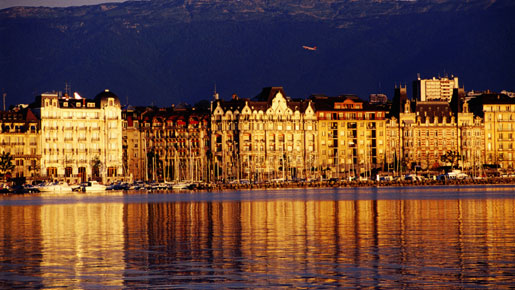
It’s a beautiful setting for a truly international city. Between the Alps and the Jura mountains, close to Switzerland’s border with France, Geneva curves elegantly around the tip of Lac Leman (Lake Geneva).
You might expect the European home of the United Nations and numerous high profile, world renowned organisations to be formal – uptight and stuffy even. But Geneva is a wonderfully relaxed and serene city of green parks, blue lake, cobbled Old Town, splashing fountains and flowery squares. Promenades line the shore, swans sail among moored boats and white steamers take leisurely lake cruises.
High on its hill, among a maze of quiet streets and hidden courtyards, the Old Town peaks with the spires of St Peter’s Cathedral, whose bells ring a different melody each month. Panoramic city views are the reward for climbing the 157 spiralling steps up its north tower.
The Geneva Convention was signed at the Hôtel de Ville, home to Geneva’s parliament, where a winding paved ramp once enabled horses to carry their riders right up to the third floor. Its elegant inner courtyard hosts classical music concerts in summer.
At the heart of the Old Town in La Place du Bourg-de-Four, cafés spill out onto the cobbles around a fountain blooming with summer flowers. The centre of commerce since Roman times, it is lined with houses built for exiled Protestants. Noted reformers were welcomed into the city – there’s even a commemorative Reformation Wall of statues and bas-reliefs in leafy Bastions Park.
The Jet d’Eau is the city’s symbol. The water fountain in the lake was originally a security valve at a hydraulic factory. It propels 500 litres of water per second, to a height of 140 metres, at 200km an hour, and can be seen soaring skywards from early March to mid-October.
Elegant mansions have lake views. Sir Robert Peel built one of them, the pink-painted Villa Barton, creating a classic English garden and planting a forest of giant sequoia trees. There are miles of leafy lakeside walks amid rare trees in sculpture-dotted parks. In summer, the scent of 40,000 rosebushes perfumes the air.
Anyone with an interest in art and history will love Geneva, which boasts over 40 museums. They span the life and work of the city’s most famous son, the 18th-century philosopher Jean-Jacques Rousseau, through watch-making to works by Renaissance artists and modern sculptors. At the Musée Ariana, seven centuries’ of beautiful ceramics and glass are elegantly displayed in an oval neo-Classical building that was purpose-built to display one man’s collection. But if you only see one museum during your stay, make it the powerful, moving and brilliantly presented International Red Cross and Red Crescent Museum opposite the Palais des Nations.
Separated from Geneva by the River Arve, and with an atmosphere all its own, Carouge was developed after 1754 when the land was given to the Kingdom of Sardinia. Although designed by architects from Turin, with its plane trees and shuttered windows, market square, imaginative boutiques, antiques shops, patisseries, cafés and art galleries, it feels very French. Only about 10 minutes by tram from the city centre, it’s a pleasing side-trip.
There’s much to enjoy in this city of stylish shops and fine dining, trendy bars and lively clubs. Be there in June for the Music Festival, when for three days the whole city turns into a huge musical stage and hundreds of concerts of all types are performed in the streets. On warm summer nights, when the Jet d’Eau soars white against a clear, midnight-blue sky and the lights of the city reflect their colour in the gently lapping water, there’s a sense of quiet magic in the air.

